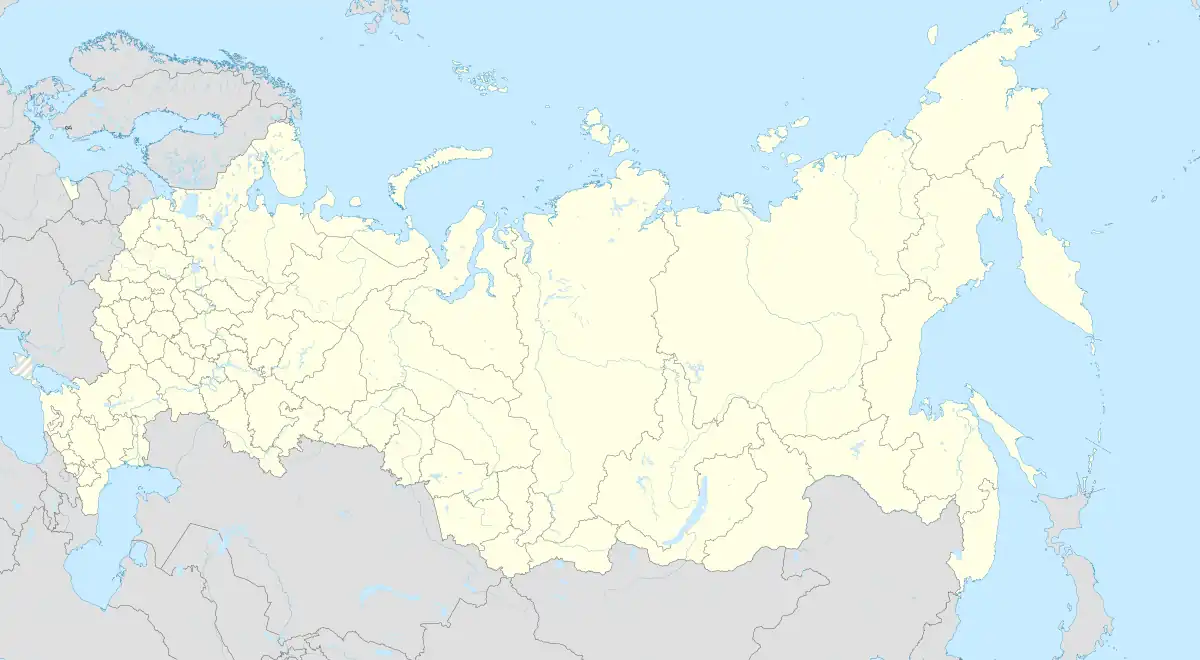Armavir Radar Station
Armavir Radar Station (Russian: Радиолокационная станция (РЛС) в Армавире) is an early warning radar station near Armavir in Krasnodar Krai, Russia. It is a key part of the Russian early warning system against missile attack and is run by the Russian Space Forces. There are two radars here - one faces south west and one south east. They provide radar coverage of the Middle East.
Armavir Radar Station | |
|---|---|
РЛС в Армавире | |
| Armavir, Krasnodar Krai, Russia | |
 Armavir Radar Station | |
| Coordinates | 44.925106°N 40.983894°E |
| Type | Radar Station |
| Height | 30 metres (98 ft)[1] |
| Site information | |
| Owner | Russian Aerospace Forces |
| Controlled by | Russian Space Forces |
| Open to the public | no |
| Condition | operational |
| Site history | |
| Built | 2006- |
| Built by | Russia |
| In use | Russia |
| Garrison information | |
| Current commander | Vadim Severov (2009)[1] |
The station is located on the former Baronovsky Airfield (Russian: аэродром Бароновский) 3 kilometres (1.9 mi) south west of the village of Glubokiy and 12 kilometres (7.5 mi) south west of Armavir.
The station was described as starting to operate at the end of 2006 [2] and then entering "experimental combat mode" in 2008.[3] On the day in 2009 that Russia lost coverage from radars in Ukraine it was announced that it had "begun operations".[4] In May 2012 it was announced that it would go on combat duty before the end of 2012.[5] In December 2012 it was announced it will be in the first quarter of 2013.[6] 6 June 2013 commissioned by order of the President Vladimir Putin visiting the Central Command Post of the Russian Armed Forces.[7] Planned second segment, which will overlap zone of the Gabala radar station.
It was developed by NIIDAR (НИИДАР) and was built by Spetsstroy (Федеральное агентство специального строительства, also called Спецстрой России). Equipment installation was performed by Spetstehmontazh (Спецтехмонтаж).[1]
Voronezh radar
Voronezh radar are highly prefabricated radars needing fewer personnel and using less energy than previous generations. There are two in Armavir [8] and they are described as Voronezh-DM,[9] a UHF radar with a stated range of 4,200 kilometres (2,610 mi).[10]
One of the radars, facing southwest, replaces the coverage lost [4] by the dispute with Ukraine over the Dnepr radars in Mukachevo and Sevastopol.[11] The other, facing south east, can replace the Daryal radar in Gabala although it is behind in construction.
.svg.png.webp)
Armavir and Gabala
Data from Armavir, together with Gabala was offered to the United States as part of the negotiations over Russian opposition to US missile defence in Europe. Armavir is close to Iran, like Gabala, and also provides intelligence on missile activity in the Middle East.[12]
Armavir cannot completely counter the loss of Gabala. Gabala is further south and has a longer range. Armavir may also be affected by the Caucasus Mountains.[12]
In 2007 Vladimir Popovkin, then commander of the Russian Space Forces, said that Gabala, together with Balkhash in Kazakhstan and the two stations in Ukraine, cannot be relied upon as Russia cannot be sure it will have access to them in periods of international tension and war.[13]
2013 ballistic launch in Mediterranean
On 3 September 2013 Armavir detected two US/Israeli ballistic test launches in the Mediterranean towards Syria.[14]
References
- Всевидящий глаз России [Seeing Eye Russia]. Novosti Kosmonavtiki (in Russian). Eastview (5): 52–53. May 2009. Archived from the original on 19 December 2013. Retrieved 21 May 2012.(subscription required)
- Podvig, Pavel (22 December 2006). "The early-warning radar in Lekhtusi entered service". Russian Strategic Nuclear Forces. Archived from the original on 6 April 2012. Retrieved 13 April 2012.
- Podvig, Pavel (29 December 2007). "Delay with the early-warning radar at Armavir". Russian Strategic Nuclear Forces. Archived from the original on 9 May 2012. Retrieved 13 April 2012.
- Podvig, Pavel (12 February 2009). "Armavir radar fills the gap". Russian Strategic Nuclear Forces. Archived from the original on 20 April 2013. Retrieved 9 January 2012.
- "Новая РЛС в Армавире заступит на боевое дежурство до конца года" [The new radar station in Armavir is to step up to combat duty before the end of the year]. RIA Novosti. 5 May 2012. Archived from the original on 12 June 2012. Retrieved 21 May 2012.
- "В России в 2013 году начнется строительство нескольких новых РЛС" [Russia will build several new radars in 2003]. RIA Novosti. 1 December 2012. Archived from the original on 3 December 2012. Retrieved 2 December 2012.
- "Владимир Путин посетил Центральный командный пункт Вооруженных Сил России - Телеканал «Звезда»". 6 June 2013. Archived from the original on 5 July 2014. Retrieved 1 June 2014.
- Podvig, Pavel (14 February 2009). "Two radars at Armavir". Russian Strategic Nuclear Forces. Archived from the original on 20 April 2013. Retrieved 9 January 2012.
- Модернизация радаров СПРН в Северо-Западном округе начнется в 2015 году [Upgrading early warning radars in the Northwest District will begin in 2015] (in Russian). Lenta.ru. 12 December 2011. Archived from the original on 13 July 2012. Retrieved 9 January 2012.
- Радиолокационная станция высокой заводской готовности "Воронеж-ДМ" [Radar of high prefabrication Voronezh-DM] (in Russian). Russian Ministry of Defence. n.d. Archived from the original on 24 January 2013. Retrieved 8 February 2012.
- "Russia Won't Rent Ukrainian Radar". Kommersant. 16 January 2008. Archived from the original on 4 March 2016. Retrieved 30 January 2012.
- Sokhov, Nikolai (2010). "Missile Defence: Towards Practical Cooperation with Russia". Survival: Global Politics and Strategy. 52 (4): 121–130. doi:10.1080/00396338.2010.506825. S2CID 155084027.
- Marinin, I; Kuznetsov, A (February 2007). "THE FIRST VORONEZH ON EXPERIMENTAL COMBAT DUTY". Novosti Kosmonavtiki. Eastview (2): 64–65. Archived from the original on 19 December 2013. Retrieved 18 June 2012.(subscription required)
- "Missiles launched in Mediterranean towards Syrian coast, claims Russian defence ministry - Telegraph". Archived from the original on 24 January 2018. Retrieved 3 April 2018.